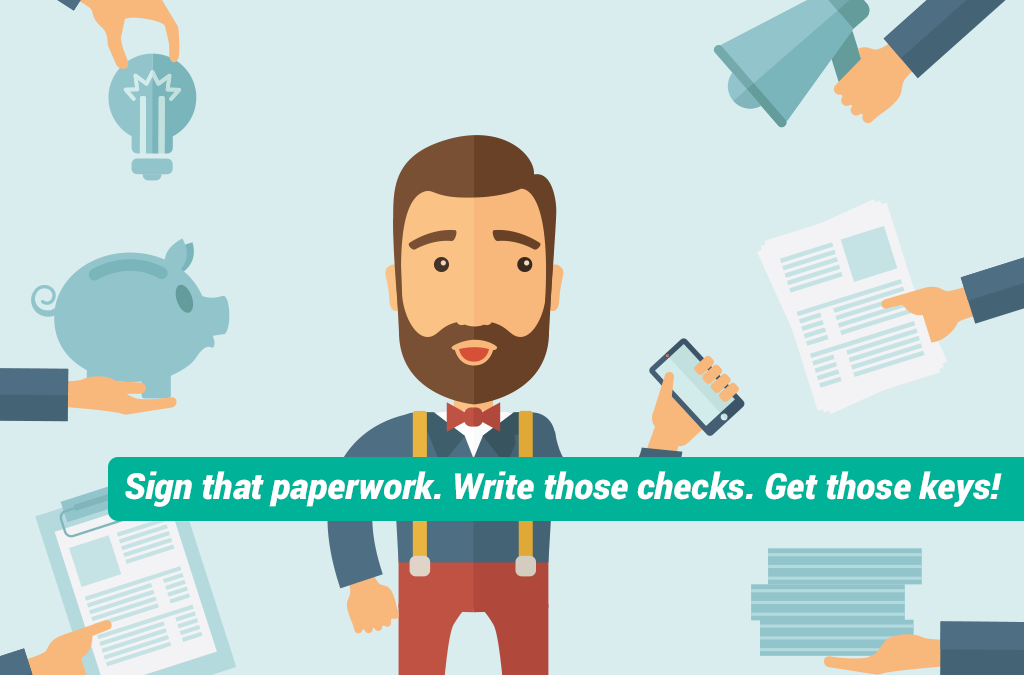Article From HouseLogic.com
By: HouseLogic
Published: February 27, 2018
Sign that paperwork. Write those checks. Get those keys!
The closing. It all comes down to this. The grand finale. Once you have the keys, the house is yours. (Cue: Air horn sound!)
The closing. It all comes down to this. The grand finale. Once you have the keys, the house is yours. (Cue: Air horn sound!)
Nice work getting this far. You’re almost a homeowner! Let’s run through some questions you may have as you cross the finish line.
What Does “Closing” Mean?
The close or settlement is when you sign the final ownership and insurance paperwork and get the home’s keys.
The closing process technically begins when you have signed a purchase and sale agreement. That agreement should specify a closing date. Typically — from the signing date to the closing date — closing takes four to six weeks. During this time, purchasing funds are held in escrow, where your money is safe until the deal is officially done.
What’s a Closing Disclosure?
Lenders must provide borrowers with a Closing Disclosure, or CD, at least three days before settlement. This form is a statement of your final loan terms and closing costs.
You have three days to start_tip 89 review the CD. end_tip Compare it to the Loan Estimate you received shortly after you applied for the loan. If you need a refresher on Loan Estimates, you can view a sample version here.)
The point of this formal review process is to ensure there are no surprises at the closing table. If there’s a significant discrepancy between the Loan Estimate and CD, notify your lender and title company immediately. Depending on what the underlying issue is, the closing has to stop and a new closing disclosure must be sent out with a new three-day review period.
There are a couple things on the LE that can’t change by the time you get the CD — namely interest rate and lender fees. Some items can change by only 10% (fees paid to local government to record the mortgage might be one); and others can change without limit, like prepaid interest, because it can’t be predicted at the start of the loan process.
Explore More Topics:
Prepare for Closing
Buy a Home: Step-by-Step
When Will the Final Walk-Through Happen?
Most real estate sale contracts allow the buyer to walk through the home within 24 hours of settlement to check the property’s condition. During this final inspection, which usually takes about an hour, you and your agent will make sure any repair work that the seller agreed to make has been completed.
During the walk-through, you’ll also double-check that everything in the house is in good working order. Be sure to:
- Run water in all the faucets and check for leaks under sinks.
- Test appliances.
- Check the garage door opener.
- Flush toilets.
- Open and close all doors.
- Run the garbage disposal and exhaust fans.
If the home is in good shape — woo-hoo! Your next stop is the closing table.
If anything is amiss, your agent will contact the listing agent and, in most cases, negotiate to get the seller to compensate you at closing — typically in the form of a personal check — for the costs of fixing the problems yourself.
Worst-case scenario: You have to delay closing to resolve problems. In the unlikely event that happens, your agent will help you address the issue.
Who’s Invited to The Closing?
Certain people will be there. Who, exactly, depends on your state. Typically, you will be joined by:
- Your agent
- The seller
- The seller’s agent
- A title company representative
- Your loan officer
- Any real estate attorneys involved in the transaction
The closing usually takes place at the title company, attorney’s office, or the buyer’s or seller’s agent’s real estate office. FYI: Some states, like California, don’t require an in-person, sit-down closing because they’ve enacted legislation that allows for electronic closings with remote notaries.
Nonetheless, as the home buyer, you’ll have to sign what might seem like a mountain of paperwork — including the deed of trust, promissory note (promising the lender you’ll pay back the loan), and other documents. That cramp in your wrist will be worth it once everything is done.
How Much Will I Pay for Closing Costs?
If you’ve heard people vent frustration with the process of buying a home, then you’ve likely heard complaints about unexpected costs at closing. Let’s unpack what you should expect so you’re not surprised, too.
Closing costs can vary widely by location and your home’s purchase price. Costs are split between you and the seller, but as the buyer you’ll cover the lion’s share. You can generally expect your closing costs to be 3% to 4% of the home’s sales price. So, on a $300,000 home, you can pay anywhere from $9,000 to $12,000 in closing costs. (Meanwhile, the seller typically pays closing costs of 1% to 3% of the sales price.)
You can try to predict closing costs with calculators like Nerdwallet’s, which lets you plug in your mortgage details to get a rough estimate of what your costs will be.
Closing fees often include (but are not limited to):
- Commission for the buyer’s agent and seller’s agent
- A loan application fee
- An origination fee, which lenders charge for processing your loan
- The appraisal fee
- A fee for pulling your credit report
- An underwriting fee, which covers the lender’s costs of researching whether to approve you for the loan
- A title search fee
- Property taxes, which are due within 60 days of the purchase
- A recording fee for filing a public land record with the courthouse
These fees are a bummer. The bright side: Almost all of them are one-time deals.
What Should I Bring? (Other than Champagne?)
At the closing you should have:
- A government-issued photo ID
- A copy of the ratified sales contract
- A homeowner’s insurance certificate
- Proof of flood insurance, if you’re buying a home in a flood zone
- A cashier’s check, or proof of start_tip 90 wire transfer, end_tip to cover the remainder of the down payment and your closing costs
Also, talk to your attorney about anything else you might need to bring depending on your state or personal circumstances (such as a separation or divorce decree, should your relationship status affect the closing).
What Is Title Insurance and Why Do I Need It?
Every lender requires borrowers to purchase title insurance — a policy that protects you and the lender from outside claims of ownership of the property. Wait, you may be asking, some random person could show up and claim they own the house? Sounds crazy, but it happens.
Let’s say a previous owner didn’t pay all of their property taxes. Because those taxes remain against the property, the taxing entity could potentially take your home if you don’t have a “clean” title. Title insurance also protects you from ownership claims over liens, fraudulent claims from previous owners, clerical problems in courthouse documents, or forged signatures.
The title company will perform a comprehensive search of deeds, wills, trusts, and public records to trace the property’s history and verify that you’re becoming the rightful sole owner of the property.
Typically, lenders have a preferred title company they work with, but it’s ultimately the buyer’s decision as to which title company to use. Your agent could offer a few referrals.
Title insurance comes in two forms:
Lender’s title insurance, which (no surprise) protects the lender. It’s required. Owner’s title insurance, which protects you. It’s optional but recommended because it covers your interest in the property. If the insurance company loses a battle over the title in the future but you purchased owner’s title insurance, you’re fully protected. Owner’s title insurance will also cover your legal fees if you have to defend your ownership rights in court.
Unlike most insurance policies, such as homeowner’s insurance, car insurance, and life insurance, title insurance is paid as a one-time fee at closing. The average cost of title insurance is about $544 for the lender’s policy and about $830 for the homeowner’s policy, according to ValuePenguin data. However, costs can vary significantly depending on the home you’re buying, where it’s located, and how much legwork the title company has to perform.
What If There are Last-Minute Issues? Should I Panic?
For your loan to be approved, it has to go through underwriting. The underwriter’s job is to start_tip 91 validate all of your financials end_tip — confirming that your income, credit, and debt haven’t changed since you were pre-approved for the loan — as well as to review the property’s characteristics and appraisal. If everything checks out, your mortgage will be approved.
If something goes wrong during underwriting though, you’ll have to address the problem before you can close on the home. Let’s say your credit score dropped because you recently purchased a car with an auto loan, or maxed out your credit cards.This isn’t necessarily dire, but you may need to delay closing as you work with your lender to take steps to raise your score. (Also, for that reason, it’s a good idea to hold off on big purchases, avoid overusing a credit line, and doing really anything that could result in a credit inquiry until after the closing.)
OK — Can I Celebrate Now?
If you’ve made it through close ? YES! Once you’ve climbed that mountain of paperwork and have those keys in your hands, you now officially, finally own a home.
Congratulations! You put in a lot of hard work — including to build relationships with your agent, your lender, and other experts along the way.
Now it’s time to start investing in other relationships. Like with your new neighbors 🙂























